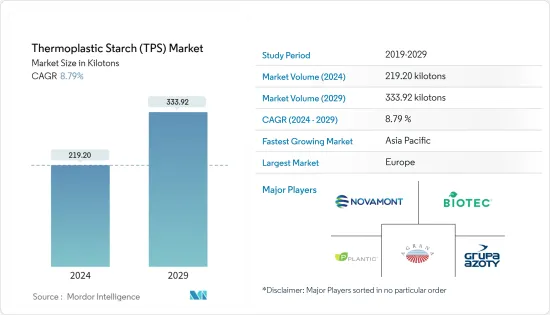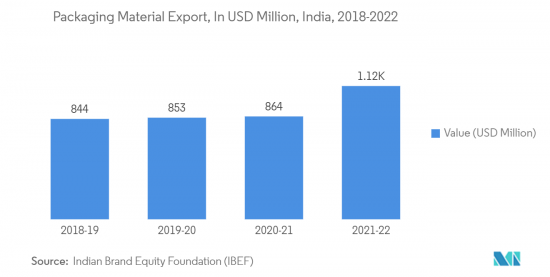 |
市場調査レポート
商品コード
1406063
熱可塑性デンプン(TPS) - 市場シェア分析、産業動向と統計、2024年~2029年の成長予測Thermoplastic Starch (TPS) - Market Share Analysis, Industry Trends & Statistics, Growth Forecasts 2024 - 2029 |
||||||
● お客様のご希望に応じて、既存データの加工や未掲載情報(例:国別セグメント)の追加などの対応が可能です。 詳細はお問い合わせください。
| 熱可塑性デンプン(TPS) - 市場シェア分析、産業動向と統計、2024年~2029年の成長予測 |
|
出版日: 2024年01月04日
発行: Mordor Intelligence
ページ情報: 英文 120 Pages
納期: 2~3営業日
|
- 全表示
- 概要
- 目次
熱可塑性デンプン市場規模は2024年に219.20キロトンと推計され、2029年には333.92キロトンに達し、予測期間(2024年~2029年)のCAGRは8.79%で成長すると予測されます。

COVID-19のパンデミックは2020年の市場にマイナスの影響を与えました。その間、製造活動が一時的に停止され、成分としての熱可塑性デンプンの使用量が減少し、市場に影響を与えました。しかし、規制が緩和されたことで、市場はここ数年でペースを取り戻し始めました。
主なハイライト
- 包装業界からの需要の増加と、バイオプラスチックの利用拡大に関する政府の好意的な政策が、市場拡大の原動力となりそうです。
- 逆に、TPSに関連する複数の技術的制約が市場成長の妨げになる可能性が高いです。
- 熱可塑性澱粉の特性を向上させるための技術進歩や技術革新は、予測期間中、調査対象市場にとって好機となりそうです。
- 欧州は世界の熱可塑性デンプン市場の主要地域であり、アジア太平洋は調査対象市場の急成長地域です。
熱可塑性デンプン(TPS)市場の動向
包装フィルムからの需要増加
- 熱可塑性デンプンフィルムの使用は、天然資源の明確な利用を示し、それによって環境汚染を減少させる。熱可塑性デンプンフィルムは、生分解性、低コスト、加工のしやすさ、再生可能性など多くの利点を備えています。デンプンフィルムは、食品の賞味期限を延ばすための有望な商業用保存フィルムとして利用されています。
- 熱可塑性デンプン(TPS)はデンプン誘導体であり、包装産業において合成ポリマーの代わりに使用できる最も適した材料として広く受け入れられています。
- 持続可能な包装材料としての加水分解コーンスターチフィルムの応用は、従来の石油ベースのプラスチックと比較して、生分解性、再利用性、環境負荷の低減など、いくつかの利点を付与します。
- 多くの企業が持続可能な包装材料へとシフトしています。例えば、米国を拠点とする世界な原料ソリューション企業であるイングレディオンは、高アミロースで白色からオフホワイト色のコーンスターチ、クリスプ・フィルムを提供しています。この製品は優れたフィルム形成特性を持ち、揚げ物のコーティングに使用すると保護バリアとして機能します。
- 米国農務省(USDA)によると、農業研究局(ARS)の科学者たちは、紙やその他の素材をより耐水性に優れ、生分解性にする能力を持つデンプンベースのフィルム(コーティング剤)を開発しました。このフィルム製品は食品包装やビニール袋などに広く使用され、埋立地を詰まらせる合成製品の量を減らしています。
- 2022年8月、インドを拠点に一般的なプラスチック包装用品の環境に優しい製品の製造に携わるラファブリカ・クラフト社(LaFabrica Craft Pvt Ltd)は、天然バイオポリマーを使用した完全生分解性のシャンプー・サシェとチャツネ・パケを開発しました。この小袋の素材は、トウモロコシ、タピオカでんぷん、海藻、カゼインなどの有機物質から作られています。また2022年8月には、オーストラリアを拠点とするバイオマテリアル企業のグレート・ラップ社が、廃棄ジャガイモから作られたクリンフィルムに代わる堆肥化可能なバイオプラスチックの誕生を発表しました。
- したがって、これらすべての要因は、予測期間中に調査された市場の需要に影響を与えると予想されます。

アジア太平洋地域は急成長地域
- アジア太平洋地域では、ライフスタイルの変化、可処分所得の増加、社会人の増加、ファーストフード志向の高まりにより、包装食品の需要が伸びています。消費者が調理済み食品を好むのは、調理時間が大幅に短縮されるからです。加えて、調理済み食品は新鮮で、魅力的で丈夫な包装をしており、この市場の需要を支えています。
- 中国は、一人当たり所得の増加やeコマース大手の台頭などの要因により、世界最大の包装材消費国です。Interpakによると、中国では2023年に食品包装カテゴリーの総包装量が4,470億個に達する見込みであり、包装業界からの熱可塑性デンプンに対する需要の増加を示しています。
- インドでは、食品加工が包装の最大消費者で45%、次いで医薬品とパーソナルケア製品となっています。これらのエンドユーザー分野からの需要の増加は、拡大の大きな可能性を生み出しています。飲食品産業はインドのGDPの約3%を占め、730万人以上の従業員を抱える同国最大の雇用主です。こうしたすべての要因が、調査対象市場の有望な見通しを示しています。
- 日本では、国民1人当たり年間約300~400枚、日本全体で400億枚以上のレジ袋が使用されています。したがって、日本では従来のレジ袋に対する規制が強まっており、予測期間中、TPSベースの製品に対する需要が高まると予想されます。
- 日本の消費者の多くが食品により高い予算割合を割り当てるようになっているため、投資家や国際ブランドが包装市場に参入し、地産地消型の新しい食品包装嗜好を導入するさまざまな機会が待ち受けています。このように、TPS市場は日本のパッケージング市場において将来的なチャンスを秘めています。
- 中国の3Dプリンティング産業は、世界で最もダイナミックで急成長している産業のひとつです。米国に次いで世界第2位の市場です。中国には、インテリジェントなウェアラブル機器の設計・開発に注力するHeyGearsや、3Dプリンティング技術を使って歯科矯正装置を設計・製造する上海Smartee Denti-Technologyなど、約310社の3Dプリンティング新興企業があります。同社は、従来のワイヤー矯正に代わるものとして、独自の「Invisible treatment technology」に基づき、目に見えない3Dプリント矯正装置を開発しました。
- 現在、インドには3Dプリンティングセンターは数少ないが、ヘルスケアや医療技術の企業がこの分野に参入しています。メーカーが増えればコストも下がります。また、広く使用され、治療に対する需要があれば、一人当たりの価格も下がり、さらにコストも安くなります。その結果、調査された市場に影響を与えることになります。
- 日本では高齢化が進んでおり、オーダーメイドの医療機器やインプラントの需要が高まっています。3Dプリンティング技術は、こうした機器を迅速かつ低コストで製造するために利用できます。さらに、日本には活気あるクリエイティブ産業があり、3Dプリンティング技術はファッション、アート、デザイン分野向けにカスタマイズされたユニークな製品を製造することができます。
- そのため、アジア太平洋地域では予測期間中、さまざまなエンドユーザー産業からの熱可塑性デンプンの需要が増加すると予想されます。
熱可塑性デンプン(TPS)産業の概要
熱可塑性デンプン(TPS)市場は統合されており、少数の大手企業がかなりの部分を占めています。主要企業(順不同)には、Novamont SPA、BIOTEC、クラレ(Plantic)、AGRANA Beteiligungs AGなどがあります。
その他の特典:
- エクセル形式の市場予測(ME)シート
- 3ヶ月間のアナリスト・サポート
目次
第1章 イントロダクション
- 調査の前提条件
- 調査範囲
第2章 調査手法
第3章 エグゼクティブサマリー
第4章 市場力学
- 促進要因
- 包装業界からの需要増加
- バイオプラスチックを促進する有利な政府政策
- 抑制要因
- TPSに関連する複数の技術的制約
- 業界バリューチェーン分析
- ポーターのファイブフォース分析
- 供給企業の交渉力
- 消費者の交渉力
- 新規参入業者の脅威
- 代替品の脅威
- 競合の程度
第5章 市場セグメンテーション(市場規模)
- 製造タイプ
- 押出成形
- 射出成形
- 用途
- バッグ
- フィルム
- 3Dプリント
- その他の用途(使い捨て食器(カトラリー)、その他)
- 地域
- アジア太平洋
- 中国
- インド
- 日本
- 韓国
- ASEAN諸国
- その他のアジア太平洋
- 北米
- 米国
- カナダ
- メキシコ
- 欧州
- ドイツ
- 英国
- イタリア
- フランス
- 北欧諸国
- その他の欧州
- 世界のその他の地域
- 南米
- 中東・アフリカ
- アジア太平洋
第6章 競合情勢
- 合併、買収、合弁事業、提携、協定
- 市場ランキング分析
- 主要企業の戦略
- 企業プロファイル
- Agrana Beteiligungs-AG
- Biome Bioplastics Limited
- Biotec Biologische Naturverpackungen Gmbh & Co. KG
- Biologiq Inc.
- Cardia Bioplastics
- Great Wrap
- Grupa Azoty
- Kuraray Co. Ltd(PLANTIC)
- Novamont SPA
- Rodenburg Biopolymers
第7章 市場機会と今後の動向
- 熱可塑性デンプンの特性を高める技術の進歩と革新

The Thermoplastic Starch Market size is estimated at 219.20 kilotons in 2024, and is expected to reach 333.92 kilotons by 2029, growing at a CAGR of 8.79% during the forecast period (2024-2029).
The COVID-19 pandemic had a negative impact on the market in 2020. During that time, manufacturing activities were temporarily halted, reducing the usage of thermoplastic starch as a component and thereby impacting the market. However, with the ease of the restrictions, the market started to gather pace over the past couple of years.
Key Highlights
- The increasing demand from the packaging industry and favorable government policies regarding the increased usage of bio-plastics are likely to fuel the market expansion.
- On the contrary, multiple technical constraints associated with TPS will likely hinder the market's growth.
- The technological advancements and innovation to enhance the properties of thermoplastic starch is likely to act as an opportunity in the forecast period for the market studied.
- Europe is the leading region in the global thermoplastic starch market, whereas Asia-Pacific is the fastest-growing region in the market studied.
Thermoplastic Starch (TPS) Market Trends
Increasing Demand from the Packaging Films
- The use of thermoplastic starch films displays a lucid use of natural resources, thereby reducing environmental pollution. Thermoplastic starch films present many advantages, such as biodegradability, low cost, ease of processing, and renewability. The starch films are being used as a promising kind of commercial preservation film for extending the shelf of food.
- Thermoplastic starch (TPS) is a starch derivative and is widely accepted as the most suitable material that can be used in place of synthetic polymers in the packaging industry.
- The application of hydrolyzed corn starch films as a sustainable packaging material grants several advantages, such as biodegradability, reusability, and reduced environmental impact compared to traditional petroleum-based plastics.
- Many companies are shifting towards sustainable packaging materials. For instance, Ingredion, a United States-based global ingredients solutions company, offers CRISP FILM, a high amylose, white to off-white colored corn starch. The products offer good film-forming characteristics and act as a protective barrier when used as a coating for fried foods.
- According to the United States Department of Agriculture, USDA, scientists from the Agricultural Research Service (ARS) developed starch-based film, or coating, with the ability to make paper and other materials more water-resistant and biodegradable. The film product is widely used in food packaging, plastic bags, and other products, reducing the amount of synthetic products clogging landfills.
- In August 2022, LaFabrica Craft Pvt Ltd, an India-based company involved in the production of eco-friendly products for common plastic packaging items, developed a fully biodegradable shampoo sachets and chutney packets using a natural biopolymer. The sachet material has been derived from organic substances such as corn, tapioca starch, seaweed, and casein. Also in August 2022, Great Wrap, an Australian-based biomaterials company, announced the creation of a compostable bioplastic alternative to clingfilm made from waste potatoes.
- Therefore, all these factors are expected to impact the demand for the market studied during the forecast period.

The Asia-Pacific Region is the Fastest Growing Region
- In Asia-Pacific, the demand for packaged food is growing, owing to lifestyle changes, the growing disposable income, the increasing number of working professionals, and the growing preference for fast food. Consumers prefer ready-to-consume foods because they have considerably less time to cook. In addition, ready-to-consume foods are fresh and have attractive and sturdy packaging, supporting the demand for the market studied.
- China is the world's largest consumer of packaging materials globally owing to factors such as growing per capita income and rising e-commerce giants. According to Interpak, in China, total packaging in the foodstuff packaging category is expected to reach 447 billion units in 2023, indicating an increased demand for thermoplastic starch from the packaging industry.
- In India, food processing is the largest consumer of packaging at 45%, followed by pharmaceuticals and personal care products. Increasing demand from these end-user segments is creating a massive potential for expansion. The food and beverages industry accounts for about 3% of India's GDP and is the single largest employer in the country, with more than 7.3 million workforces. All such factors showcase a promising outlook for the market studied.
- In Japan, every person in the country uses around 300-400 plastic bags annually, or more than 40 billion for the entire nation. Thus, the increasing regulations on traditional plastic bags in the country are expected to propel the demand for TPS-based products during the forecast period.
- As the increasing number of Japanese consumers allocate a higher budget percentage for food, various opportunities await investors and international brands to enter the packaging market and introduce new food packaging preferences for local consumption. Thus, the TPS market holds future opportunities in the Japanese packaging market.
- The Chinese 3D printing industry is one of the world's most dynamic and rapidly growing. It is the second-largest market in the world, after the United States. There are about 310 3D printing startups in China, including HeyGears, focusing on designing and developing intelligent wearable equipment; Shanghai Smartee Denti-Technology Co. Ltd uses 3D printing technology for designing and producing orthodontics. The company developed invisible 3D printed braces based on its proprietary "Invisible treatment technology" as a replacement for traditional wire braces.
- There are a few 3D printing centers in India right now, but several healthcare and medical tech companies have entered this segment. The cost will also be reduced if there are more manufacturers. The per capita price also decreases if there is widespread use and demand for treatment; moreover, it costs less. This results in an impact on the market studied.
- Japan has an aging population, which is driving demand for customized medical devices and implants. 3D printing technology can be used to produce these devices quickly and at a low cost. Moreover, Japan has a vibrant creative industry, and 3D printing technology can produce customized and unique products for the fashion, art, and design sectors.
- Therefore, the demand for thermoplastic starch from various end-user industries is expected to increase during the forecast period in Asia-Pacific.
Thermoplastic Starch (TPS) Industry Overview
The thermoplastic starch (TPS) market is consolidated, with a few major players dominating a significant portion. Some major companies (not in any particular order) include Novamont SPA, BIOTEC, Kuraray Co. Ltd (Plantic), and AGRANA Beteiligungs AG, among others.
Additional Benefits:
- The market estimate (ME) sheet in Excel format
- 3 months of analyst support
TABLE OF CONTENTS
1 INTRODUCTION
- 1.1 Study Assumptions
- 1.2 Scope of the Study
2 RESEARCH METHODOLOGY
3 EXECUTIVE SUMMARY
4 MARKET DYNAMICS
- 4.1 Drivers
- 4.1.1 Increasing Demand from the Packaging Industry
- 4.1.2 Favorable Government Policies Promoting Bio-plastics
- 4.2 Restraints
- 4.2.1 Multiple Technical Constrains Associated With TPS
- 4.3 Industry Value Chain Analysis
- 4.4 Porter's Five Forces Analysis
- 4.4.1 Bargaining Power of Suppliers
- 4.4.2 Bargaining Power of Consumers
- 4.4.3 Threat of New Entrants
- 4.4.4 Threat of Substitute Products and Services
- 4.4.5 Degree of Competition
5 MARKET SEGMENTATION (Market Size in Volume)
- 5.1 Manufacturing Type
- 5.1.1 Extrusion Molding
- 5.1.2 Injection Molding
- 5.2 Application
- 5.2.1 Bags
- 5.2.2 Films
- 5.2.3 3D Print
- 5.2.4 Other Applications (Disposable Tableware (cutlery) and Others)
- 5.3 Geography
- 5.3.1 Asia-Pacific
- 5.3.1.1 China
- 5.3.1.2 India
- 5.3.1.3 Japan
- 5.3.1.4 South Korea
- 5.3.1.5 ASEAN Countries
- 5.3.1.6 Rest of Asia-Pacific
- 5.3.2 North America
- 5.3.2.1 United States
- 5.3.2.2 Canada
- 5.3.2.3 Mexico
- 5.3.3 Europe
- 5.3.3.1 Germany
- 5.3.3.2 United Kingdom
- 5.3.3.3 Italy
- 5.3.3.4 France
- 5.3.3.5 NORDIC Countries
- 5.3.3.6 Rest of Europe
- 5.3.4 Rest of the World
- 5.3.4.1 South America
- 5.3.4.2 Middle East & Africa
- 5.3.1 Asia-Pacific
6 COMPETITIVE LANDSCAPE
- 6.1 Mergers, Acquisitions, Joint Ventures, Collaborations, and Agreements
- 6.2 Market Ranking Analysis
- 6.3 Strategies Adopted by Leading Players
- 6.4 Company Profiles
- 6.4.1 Agrana Beteiligungs-AG
- 6.4.2 Biome Bioplastics Limited
- 6.4.3 Biotec Biologische Naturverpackungen Gmbh & Co. KG
- 6.4.4 Biologiq Inc.
- 6.4.5 Cardia Bioplastics
- 6.4.6 Great Wrap
- 6.4.7 Grupa Azoty
- 6.4.8 Kuraray Co. Ltd (PLANTIC)
- 6.4.9 Novamont SPA
- 6.4.10 Rodenburg Biopolymers
7 MARKET OPPORTUNITIES AND FUTURE TRENDS
- 7.1 Technological Advancements and Innovation to Enhance the Properties of Thermoplastic Starch
